Unit 11 Outfitting 舾装 第十一讲
- 格式:ppt
- 大小:1.24 MB
- 文档页数:47
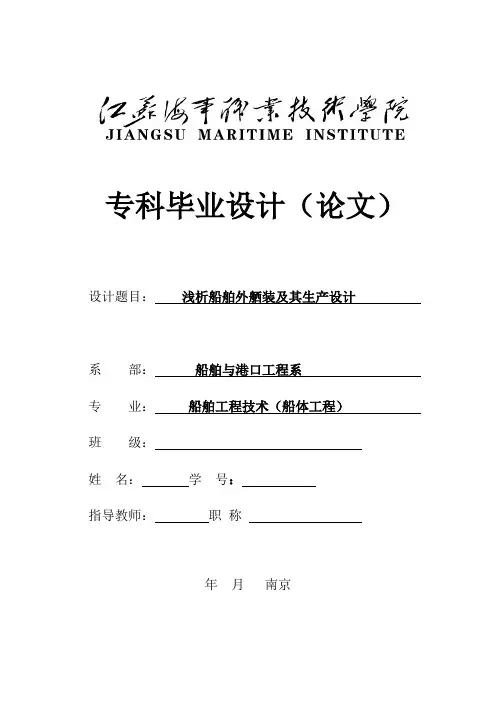
专科毕业设计(论文)设计题目:浅析船舶外舾装及其生产设计系部:船舶与港口工程系专业:船舶工程技术(船体工程)班级:姓名:学号:指导教师:职称年月南京摘要船舶外舾装是船舶舾装中的一个分支,主要包括除机舱区域和住舱区域以外所有区域的舾装工作。
它所要安装的设备和装置是多种多样的,而且随着船舶种类和用途的不同而有很大差别。
舾装技术主要包括了单元舾装、分段或总段舾装、船内舾装。
在文章中将介绍舾装的作业模式,对其进行一定的了解。
在此之前我们需要通过舾装生产设计来解决如何施工以及如何组织施工等问题,提前在图面上考虑并解决问题。
从而高效高质的完成舾装作业,缩短造船周期。
文中会阐述生产设计对于外舾装的作用以及重要性。
在生产设计中运用托盘管理这一有效的管理方法,并可以通过计算机辅助建立三维模型,有效的避免在施工时可能出现的问题。
关键词:外舾装舾装技术生产设计计算机辅助AbstractDuck outfitting is one of the branch of outfitting, inluding every zone of the outfitting except for the cabin and accommodations. A number of equipments is needed for it, and keeping changing based on the variety and the use of the ships. Technology of the outfitting contains unit outfitting, part or major outfitting, inside outfitting.In the article will introduce outfitting work, it must. Before that, we need the outfitting production design to address how to begin the work and organize it, and considering and resolving the questions shouled be put ahead to get the high quality,efficiency and short construction periods of the outfitting work.It will set production design for the outfitting role and importance .Salver management as the effective management method is asked in the production design to establisht a three-dimensional model through the computer aids to avoid the possible problem of constructions.Keywords outfitting technical production design CAM目录1 引言 (1)2 船舶舾装工程简介 (1)3 外舾装的作业模式 (1)3.1舾装件采办 (1)3.2单元舾装 (2)3.3分段舾装 (2)3.4船内舾装 (2)4 外舾装生产设计 (3)4.1舾装生产设计简介 (3)4.2舾装划分 (3)4.3舾装绘制 (3)4.4舾装发送 (4)4.5外舾装生产设计举例 (4)4.6计算机辅助外舾装生产设计 (5)5结论 (10)6致谢 (11)7参考文献 (12)1 引言舾装工程随着船体工程的不断发展也取得了相应的发展,从开始的完全船内舾装发展至今,已经变为通过先进的造船理念,进行生产设计,提高预舾装率。
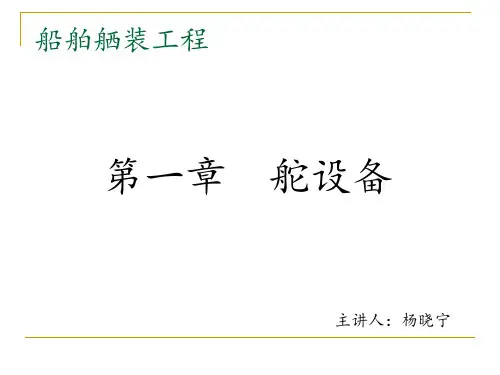
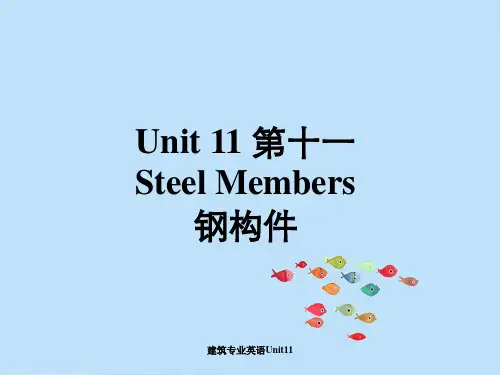

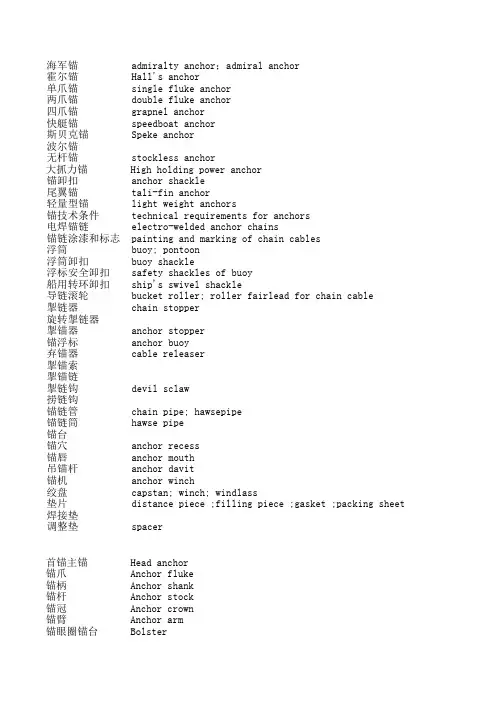
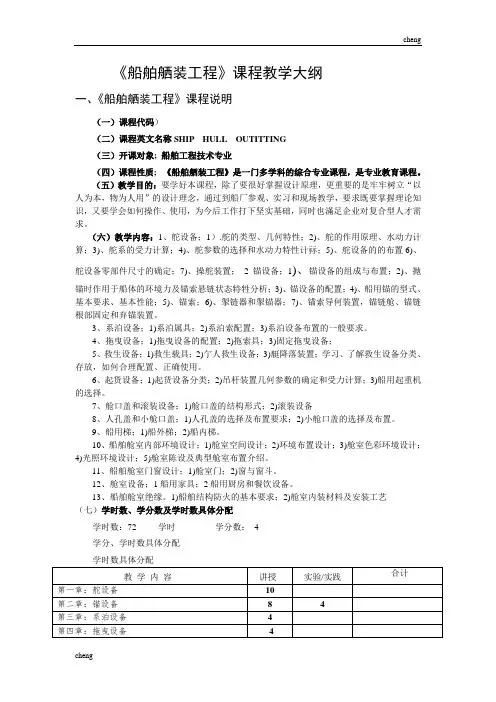
《船舶舾装工程》课程教学大纲一、《船舶舾装工程》课程说明(一)课程代码)(二)课程英文名称SHIP HULL OUTITTING(三)开课对象;船舶工程技术专业(四)课程性质;《船舶舾装工程》是一门多学科的综合专业课程,是专业教育课程。
(五)教学目的:要学好本课程,除了要很好掌握设计原理,更重要的是牢牢树立“以人为本,物为人用”的设计理念,通过到船厂参观、实习和现场教学,要求既要掌握理论知识,又要学会如何操作、使用,为今后工作打下坚实基础,同时也滿足企业对复合型人才需求。
(六)教学内容:1、舵设备;1).舵的类型、几何特性;2)、舵的作用原理、水动力计算;3)、舵系的受力计算;4)、舵参数的选择和水动力特性计祘;5)、舵设备的的布置6)、舵设备零部件尺寸的确定;7)、操舵装置;2锚设备;1)、锚设备的组成与布置;2)、抛锚时作用于船体的环境力及锚索悬链状态特牲分析;3)、锚设备的配置;4)、船用锚的型式、基本要求、基本性能;5)、锚索;6)、掣链器和掣锚器;7)、锚索导何装置,锚链舱、锚链根部固定和弃锚装置。
3、系泊设备;1)系泊属具;2)系泊索配置;3)系泊设备布置的一般要求。
4、拖曳设备;1)拖曳设备的配置;2)拖索具;3)固定拖曳设备;5、救生设备;1)救生载具;2)亇人救生设备;3)艇降落装置;学习、了解救生设备分类、存放,如何合理配置、正确使用。
6、起货设备;1)起货设备分类;2)吊杆装置几何参数的确定和受力计算;3)船用起重机的选择。
7、舱口盖和滚装设备;1)舱口盖的结构形式;2)滚装设备8、人孔盖和小舱口盖;1)人孔盖的选择及布置要求;2)小舱口盖的选择及布置。
9、船用梯;1)船外梯;2)船内梯。
10、船舶舱室内部环境设计;1)舱室空间设计;2)环境布置设计;3)舱室色彩环境设计;4)光照环境设计;5)舱室陈设及典型舱室布置介绍。
11、船舶舱室门窗设计;1)舱室门;2)窗与窗斗。
12、舱室设备;1船用家具;2船用厨房和餐饮设备。
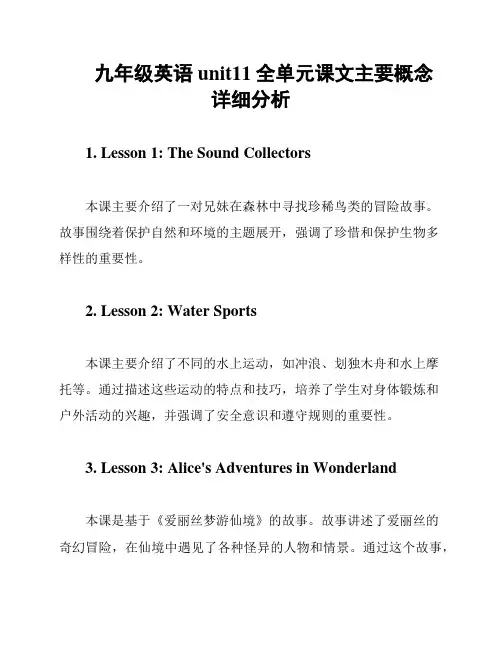
九年级英语unit11全单元课文主要概念详细分析1. Lesson 1: The Sound Collectors本课主要介绍了一对兄妹在森林中寻找珍稀鸟类的冒险故事。
故事围绕着保护自然和环境的主题展开,强调了珍惜和保护生物多样性的重要性。
2. Lesson 2: Water Sports本课主要介绍了不同的水上运动,如冲浪、划独木舟和水上摩托等。
通过描述这些运动的特点和技巧,培养了学生对身体锻炼和户外活动的兴趣,并强调了安全意识和遵守规则的重要性。
3. Lesson 3: Alice's Adventures in Wonderland本课是基于《爱丽丝梦游仙境》的故事。
故事讲述了爱丽丝的奇幻冒险,在仙境中遇见了各种怪异的人物和情景。
通过这个故事,学生能够体验奇幻的想象力和创造力,并思考现实世界和幻想世界之间的差异。
4. Lesson 4: Space Tourism本课主要介绍了太空旅游的概念,探讨了人类是否可以在将来去太空旅行。
通过讨论太空旅游的利与弊,引导学生思考科技发展对未来的影响以及人类的探索精神。
5. Lesson 5: Myths and Legends本课主要介绍了一些神话和传说的故事,如妈祖和希腊神话等。
通过了解这些传统故事,学生可以加深对不同文化的理解,并从中汲取智慧和启示。
6. Lesson 6: The Writer's Craft本课主要介绍了写作的技巧和方法。
通过分析写作中的元素和技巧,培养学生的写作能力和创造力,并使他们能够更好地表达自己的想法和情感。
以上是九年级英语unit11全单元课文的主要概念详细分析。
每节课都涉及了不同的主题和故事,旨在提高学生的语言能力和对世界的理解。
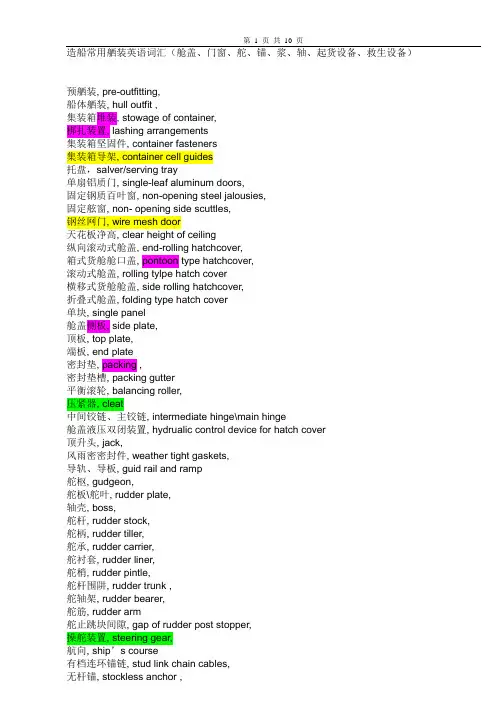
造船常用舾装英语词汇(舱盖、门窗、舵、锚、浆、轴、起货设备、救生设备)预舾装, pre-outfitting,船体舾装, hull outfit ,集装箱堆装, stowage of container,梆扎装置, lashing arrangements集装箱坚固件, container fasteners集装箱导架, container cell guides托盘,salver/serving tray单扇铝质门, single-leaf aluminum doors,固定钢质百叶窗, non-opening steel jalousies,固定舷窗, non- opening side scuttles,钢丝网门, wire mesh door天花板净高, clear height of ceiling纵向滚动式舱盖, end-rolling hatchcover,箱式货舱舱口盖, pontoon type hatchcover,滚动式舱盖, rolling tylpe hatch cover横移式货舱舱盖, side rolling hatchcover,折叠式舱盖, folding type hatch cover单块, single panel舱盖侧板, side plate,顶板, top plate,端板, end plate密封垫, packing ,密封垫槽, packing gutter平衡滚轮, balancing roller,压紧器, cleat中间铰链、主铰链, intermediate hinge\main hinge舱盖液压双闭装置, hydrualic control device for hatch cover顶升头, jack,风雨密密封件, weather tight gaskets,导轨、导板, guid rail and ramp舵枢, gudgeon,舵板\舵叶, rudder plate,轴壳, boss,舵杆, rudder stock,舵柄, rudder tiller,舵承, rudder carrier,舵衬套, rudder liner,舵梢, rudder pintle,舵杆围阱, rudder trunk ,舵轴架, rudder bearer,舵筋, rudder arm舵止跳块间隙, gap of rudder post stopper,操舵装置, steering gear,航向, ship’s course有档连环锚链, stud link chain cables,无杆锚, stockless anchor ,霍尔锚, hall anchor锚卸扣, anchor shackle锚灯, anchor light or riding light弃链器, chain quick releasing device锚唇, anchor lips锚爪, flukes锚链孔, hawser铰链形, hinge type锚链舱, chain locker,链轮, chain wheel ,掣链器, chain stopper锚链, anchor chains首锚, bower anchor,锚链与链轮啮合良好, smooth engagement of anchor chains with chain wheel ,掣链器制链, braking ability of chain stopper绞盘起锚机, capstan索缆、大缆, hawser,拖索/系船索, towline/mooring ropes,导缆器、垫木, chock windlass船用带舌插销, marine toggle pins,螺旋桨柱, propeller post,固定螺距螺旋桨, fixed pitch propeller可调螺距螺旋桨, controllable pitch propeller尾轴, the tail shaft尾轴管套, stern bush,镗杆, the boring bar,人字架, A-bracket通道, gangway,梯道/走廊/脱险通道, stairway /corridors or passageways/ escape routes,舷梯发放\翻转灵活性\可靠性, easy and reliable lowering ,hoisting and turning over, 潜水员舷梯, accommodation /gangway ladder for diver,舷梯吊架, gangway hanger,舷梯绞车, gangway ladder winches舷梯升降机, gangway lifting gear桅、起重柱及吊货杆, mast,deck crane post and derrick boom起货设备, cargo gear,起货绞车, cargo winch,克令吊座平面, crane seat压紧器楔和楔座, securing wedges and wedges seats,附件, appendage稳索眼板, guy eyeplate,叉头, fork, 叉车forklift起重机壁、极限伸距, outreach,耳环, eatbob信号桅和雷达桅, signal and radar masts,单管桅/支索桅, single tubular mast箱形桁材与构架桅, box girder and frame work masts索具, rigger,起重机、升起、吊起, hoist ,钩套, shackle颈圈, neck ring,救生衣, life suites or life -jacket,救生圈, life buoys,吊艇支架, boom crutch,吊艇钢索, cable,起艇机, boat winches,艇收放全过程, boat-lowering and hoisting from the boat,艇入水后能同时脱钩, simultaneously unhooking when the boat is afloat起艇机及附件安装准确性, correct installation of boat winches and accessories 运转灵活, ease of operation,突出舷外, extruding overboard,旋转端, swivel吊艇架、吊柱、吊柱, davit,登艇, boarding ladder护栏, fence,活动栏杆, activity railing,栏杆, guard rails,扶手, railing,折叠式栏杆, foldaway railing,衣柜, wardrobe。
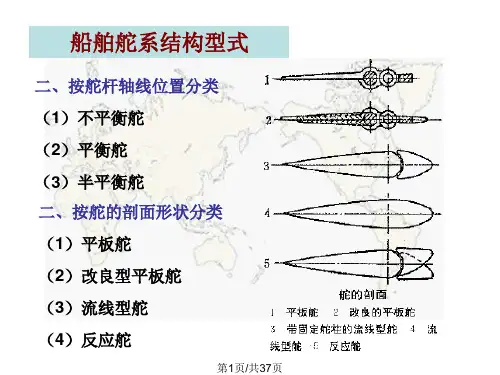
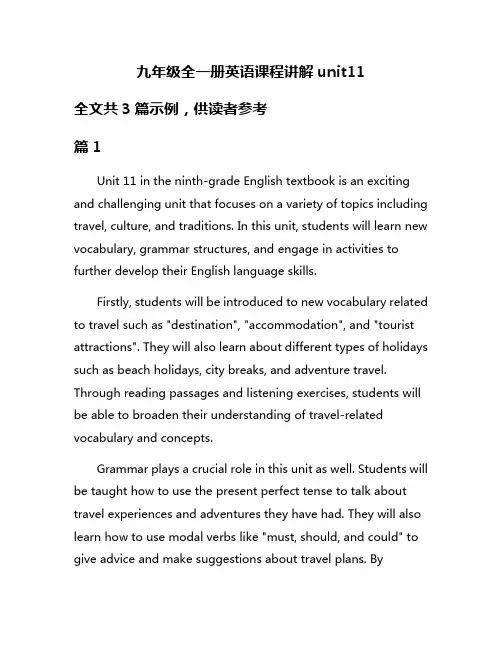
九年级全一册英语课程讲解unit11全文共3篇示例,供读者参考篇1Unit 11 in the ninth-grade English textbook is an exciting and challenging unit that focuses on a variety of topics including travel, culture, and traditions. In this unit, students will learn new vocabulary, grammar structures, and engage in activities to further develop their English language skills.Firstly, students will be introduced to new vocabulary related to travel such as "destination", "accommodation", and "tourist attractions". They will also learn about different types of holidays such as beach holidays, city breaks, and adventure travel. Through reading passages and listening exercises, students will be able to broaden their understanding of travel-related vocabulary and concepts.Grammar plays a crucial role in this unit as well. Students will be taught how to use the present perfect tense to talk about travel experiences and adventures they have had. They will also learn how to use modal verbs like "must, should, and could" to give advice and make suggestions about travel plans. Bypracticing these grammar structures through speaking and writing exercises, students will be able to confidently use them in real-life situations.Furthermore, Unit 11 also delves into cultural topics such as traditional celebrations and customs around the world. Students will learn about festivals like Carnival in Brazil, Diwali in India, and Hanami in Japan. Through reading passages and interactive activities, students will gain insight into different cultures and traditions, enhancing their cultural awareness and appreciation.In conclusion, Unit 11 in the ninth-grade English textbook is an engaging and comprehensive unit that covers a wide range of topics related to travel, culture, and traditions. By learning new vocabulary, grammar structures, and cultural knowledge, students will be able to improve their English language skills and broaden their horizons. This unit provides a solid foundation for students to continue their English language learning journey and explore the world around them.篇2Unit 11 of the ninth grade English coursebook covers a variety of interesting topics that aim to enhance students' language skills and knowledge. In this unit, students will learnabout environmental issues, wildlife conservation, and ways to protect the planet. They will also explore different types of pollution, such as air pollution, water pollution, and plastic pollution.To start off the unit, students will be introduced to vocabulary related to the environment and conservation, such as "deforestation," "climate change," and "endangered species." They will learn how to use these words in sentences and express their opinions on the topics discussed in the unit. Students will also practice reading and listening to texts about environmental issues to improve their comprehension skills.One of the key aspects of Unit 11 is the focus on writing skills. Students will learn how to write persuasive essays on topics such as why we need to protect wildlife and how we can reduce pollution in our communities. They will also have the opportunity to participate in class discussions and debates to further develop their speaking and critical thinking skills.In addition to language skills, Unit 11 also incorporates cross-curricular content, such as science and geography. Students will learn about the impact of human activities on the environment and explore ways to reduce their carbon footprint.They will also study different ecosystems and the importance of biodiversity in preserving the planet's natural resources.Overall, Unit 11 of the ninth grade English coursebook provides students with a comprehensive understanding of environmental issues and challenges facing the world today. By the end of the unit, students will have the knowledge and skills to make informed decisions about how to protect the planet and create a sustainable future for generations to come.篇3Unit 11 in the ninth-grade English curriculum covers a variety of topics, including environment, pollution, conservation, and climate change. In this unit, students will learn about the impact of human activities on the environment and the importance of taking action to protect the planet for future generations.The unit begins with a discussion on global warming and climate change, highlighting the consequences of these phenomena on the environment and the need for sustainable practices to mitigate their effects. Students will explore ways in which they can reduce their carbon footprint and contribute to the fight against climate change.Next, the unit delves into the issue of pollution, examining the different types of pollution such as air pollution, water pollution, and land pollution. Students will learn about the sources of pollution and the ways in which it can be prevented or reduced through recycling, waste management, and pollution control measures.The unit also covers the importance of conservation and biodiversity, emphasizing the need to protect endangered species and their habitats. Students will learn about the role of national parks, wildlife reserves, and conservation organizations in preserving the natural world.In addition, the unit includes discussions on renewable energy sources such as solar, wind, and hydroelectric power, highlighting their benefits in reducing greenhouse gas emissions and promoting sustainable development.Throughout the unit, students will engage in a variety of activities and discussions to deepen their understanding of environmental issues and the importance of taking action to protect the planet. They will also have the opportunity to research and present their findings on a specific environmental topic of their choice.By the end of Unit 11, students will have developed a greater awareness of the environmental challenges facing the world today and the role they can play in creating a more sustainable future. Through their learning and actions, they will be equipped to make informed decisions and contribute to positive change in their communities and beyond.。
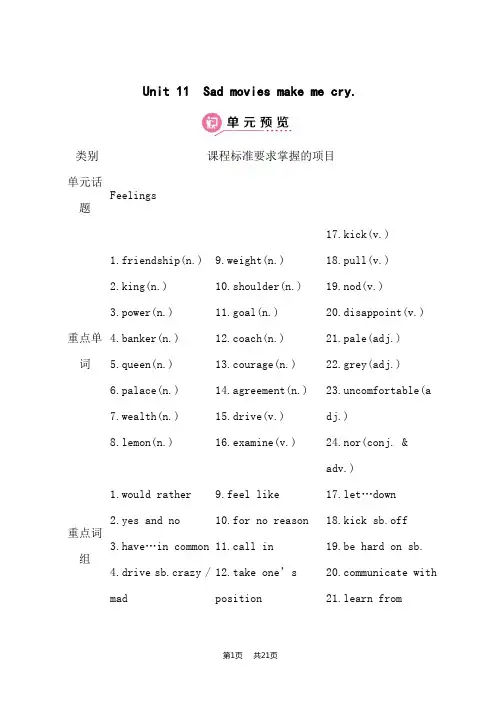
Unit 11 Sad movies make me cry.类别课程标准要求掌握的项目单元话题Feelings重点单词1.friendship(n.)2.king(n.)3.power(n.)4.banker(n.)5.queen(n.)6.palace(n.)7.wealth(n.)8.lemon(n.)9.weight(n.)10.shoulder(n.)11.goal(n.)12.coach(n.)13.courage(n.)14.agreement(n.)15.drive(v.)16.examine(v.)17.kick(v.)18.pull(v.)19.nod(v.)20.disappoint(v.)21.pale(adj.)22.grey(adj.)23.uncomfortable(adj.)24.nor(conj. &adv.)重点词组1.would rather2.yes and no3.have…in common4.drive sb.crazy /mad9.feel like10.for no reason11.call in12.take one’sposition17.let…down18.kick sb.off19.be hard on sb.municate with21.learn from5.the more…the more…6.be friends with sb.7.leave out8.a long time ago 13.to start with14.clean up15.search for16.even though22.rather than23.pull together24.in agreement重点句式1.But that music makes me sleepy.2.Did you have fun with Amy last night?3.The more I get to know Julie,the more I realize that we have a lot in common.4.He slept badly and didn’t feel like eating.5.But he found nothing wrong with his body.6.Neither medicine nor rest can help him.7.Many people are trying to take my position.8.I’m afraid I’m not happy either.9.It’s true that I’m famous and everyone loves my songs.10.The king suddenly becomes happy without the shirt of a happy person.11.How long did it take the general to find the happy man?12.Peter kept his eyes on the ground.13.His mind would not stop thinking about what happened only just an hour ago on the school soccer field.14.He had let his whole team down.15.He was really worried that his coach might kick him off the team.16.Ten minutes later,Peter heard his father knocking on his bedroom door.17.But whatever it was,don’t be too hard on yourself.18.You’re not the only reason your team lost.19.Peter went to soccer practice with courage rather than fear in his heart.单元语法1.make +sb.+do sth.的用法2.make +sb.+adj.的用法第一课时Section A(1a~2d) 重点单词drive (v.)迫使friendship (n.)友谊;友情重点词组 would rather 宁愿yes and no 既肯定又否定have …in common 有……共同点drive sb.crazy/mad 使人发疯/发狂the more …the more …越……越……be friends with sb.成为某人的朋友leave out 忽略;不提及;不包括重点句式But that music makes me sleepy.但是那首音乐使我瞌睡。
要到船厂工作的兄弟们注意啦!介绍一下【转贴】-标准化文件发布号:(9556-EUATWK-MWUB-WUNN-INNUL-DDQTY-KII要到船厂工作的兄弟们注意啦! 介绍一下【转贴】2010年11月28日船厂的工作一、船厂、船东、船检船厂:造船的,不用再解释了吧。
船东:买船的,也不用再罗嗦了吧。
一般在建船舶的船东都会在船厂派驻5-10人的检验队伍也就是船东代表。
一些财大气粗的船东甚至会派出十数人的团队比如我现在所在厂的某一船东。
船检:也就是常说的船级社了。
船检的职责是根据船舶的入级要求对船舶进行相应的检验、技术咨询并为符合要求的船舶颁发相应的入级证书。
二、船厂各部门的职能划分用脚指头想也知道一个大厂毫无疑问分了N个部门,估计毕业前大部分同学都有进过各自学校的关系厂实习吧,多少有个大概,至差也听过“生产部、设计所/技术中心”之类的名词吧。
下面给大家稍微详细的介绍点。
一般船厂大项划分为经营部门、物质部门、设计部门、生产部门。
有的厂这4个部门不是平行的,不过区别不大,管理体制不一样而已,职能应该都是相近的。
经营部门:主管经营一般船厂的船舶接单价格售后服务都由这个部门负责。
只说与船相关的其他的工资制度之类的靠边站。
物质部门:负责与船舶相应的物质,材料设备的采购。
设计部门:负责船舶的建造图纸设计,为物质部门采购提供相应的订货清单或设备技术要求,以及生产部门领料清单。
有的小厂不设专门的设计部门,所有设计由设计公司或关系船厂担纲。
生产部门:负责生产喽。
一般船舶设计经历3个阶段:初步设计、详细设计、生产设计。
在设计中有个建造规格书的谈判,一般由船厂派出精英设计团队一般由设计部门的各专业课长或专业单船主管参加,能力稍次的会有设计院的同志们协助,再次的就管技术的副总和设计院,再再次的就直接COPY别人或全权委托设计院好了。
与船东代表进行拉锯式谈判。
确定该船的各项技术参数指标。
一般一本建造规格书是要比学校的任何一部教材厚。
Unit 11 Yang Liwei’s Mission to Space短语识记:1. some day 某一天2. work at the space center 在宇宙中心工作3.on your last trip 在你的最后一次旅行4.take pictures of Earth 给地球拍照5. wave to everyone 向大家挥手6.fly through the air 在太空中飞行7.be chosen to do sth 被选出做谋事st five long years 持续五年之久9.see sb on television 在电视上看到某人10. start training for a space mission 为一项航天任务开始训练11. orbit the Earth 14 times 沿轨道饶地球14圈12. hear sb on the radio 在收音机里听到某人13.go over mountains 穿越山脉14.go through cities 穿过城市15.have a good trip 旅行愉快16.on the mission 执行任务17.blast off 立地升空18.train hard 努力训练e true 变成现实20.board the rocket 登上火箭Unit 11知识点讲解一、单词1. center n.中心;中央圆心central adj. 中心的,中央的;主要的,决定性的2. hero n.英雄,豪杰,勇士;男主角,男主人公heroes (pl.)heroic adj.3. kilometer [C]n. 公里,千米eg. kilometer stone 里程碑4. rocket n. 焰火;烟花;火箭;导弹Eg. The rocket launched from the space center.5. launch vt.发射(导弹等);使(飞机)升空Eg. launch a man-made satellite 发射人造卫星词组: launch out 出航,乘船去6. mission n.使命;天职;任务Eg. a mission to the moon 登月任务Eg. Mission impossible. 天方夜谭。
Lesson 11 细节题问题层级图目标层级图课前检测(7mins)Get a Custom(定制的)Salt Shaker for your Dining TableIf you are looking for custom salt shaker for your dining table, then there are a number of varieties available from which you can have your pick.Get custom salt shakers for custom seasoningA wooden salt shaker has a beautiful design that can enrich your dining table. It is handmade from different pieces of wood of varying sizes. It has a pear shaped body with a ceramic(陶瓷的)grinder with fancy wood finish. The ceramic grinder for making salt into powder is built to last a life time. It does not wear away like metals do when used to grind salt. It is an extremely beautiful and very delicately made gift to be given to anybody. If you buy two pieces they offer you a generous quantity of Himalayan salt.Ceramic salt shakers for custom seasoningA ceramic salt shaker is handmade and ideal to be kept in the kitchen to keep the cooking area neat and orderly. It is available in different colors, olive green, coffee brown, purple, egg blue, yellow and many more colors. You can use your fingers when you require a pinch of salt or use the spoon that accompanies it. It looks beautiful for kitchen use and can be given as a gift.Personalized salt shakers that can be given as anniversary giftsIf you are looking for handmade anniversary gifts that you would like to give to your friends, you can give hand painted salt shakers. You can send your pictures and the makers will paint the picture of your friend and her loved one. Any message you like to add will be written on the salt shaker.This cannot be put in a dishwasher or soaked in water. It has to be washed carefully by hand. If you are a person who likes eco-friendly items then you can have a salt shaker made of bamboo. It has a solid construction which makes it ideal for kitchen setting.So if you are interested in buying a salt shaker for your table, you can choose one from above and order it.1. If you prefer salt powder, you may choose______.A. a wooden salt shakerB. a bamboo salt shakerC. a ceramic salt shakerD. a hand painted salt shaker【答案】A【解析】细节题。
青少版新概念1A教案Unit11 Very smart! 真神气!句型与结构词:课文注释:图1:Thes e —this的复数形式,指示代词(比较This is my family,见第1课)。
outfit s —加-s构成的复数形式,-s在/t/后读作/s/。
outfit意为“一整套衣服或设备”。
fo r —介词,表示具体的用途或情境。
the school pla y —play,名词,意为“a piece of theatre”smar t —smart暗含的意思是“apt for the purpose”(适当的,恰当的),所以我们用它来表示“wel l-dressed/wel l-presented”(穿得好,穿戴得体);它也有“suitably clever”(聪明的)的意思。
elegant =“appropriate and graceful”(得体而优雅的)图2:um—表示说话时因犹豫而停顿。
It—单数代词:It’s very colourful. It’s my favourite tie.— It回指tie。
图3:funny— funny的基本含义是“odd”(奇怪的)或“incongruent”(不相符的,不合适的)。
因此,funny可以指“strange”(奇怪的)或“langhable”(可笑的)。
此处就是“奇怪的”意思。
shoe s —单数是shoe,复数是shoes。
规则的复数形式,复数词尾-s在元音后读作/ z/。
funny shoes—复数名词,指代一类事物时前面不加冠词(单数形式是a funny shoe)。
a bit big for you— a bit,程度副词,与表语形容词连用减轻其程度=“slightly”(有点儿)。
big for/right for— big和right与for构成固定搭配。
图4:all right=OK。
在以英语为母语的人的信件、报道以及其他非正式文件中,读者可能会见到“alright”的形式,但是,这种用法不正规,应该避免使用。
初一英语Unit 11 A Traditional Instrument(1)教科版【本讲教育信息】一. 教学内容:Unit 11 A Traditional Instrument(1)二. 重点、难点:Words, Phrases and Sentences三. 详细内容:Lesson 1(一)大声读单词1. flute n. 笛子2. string n. 弦3. lap n. (坐着时)大腿的朝上部分4. wind instrument n. 管乐器(二)重点词汇1. flute要点n. 笛,长笛Mary is good at playing the flute. 玛丽擅长吹长笛。
2. string要点:n.1)线, 带, 绳子, [美]鞋带a piece of string一根绳子, 一条带子shoe string鞋带a string of questions 一连串问题2)(弓, 乐器的)弦,the strings弦乐器string orchestra (band)弦乐队[团] string quartet(te) 弦乐四重奏(曲)3. lap要点:n.1)(人坐着时)大腿的朝上部分Her little girl sat on her lap. 她的小女儿坐在她的腿上。
e and sit on my lap. 过来,坐到我的膝上来。
2)(赛跑等的)一圈a six-lap race 六圈的赛跑4. wind instrument n. 管乐器(三)重点解析:在(2)部分中,将讲解课文部分。
Lesson 2(一)大声读单词1. look like 看起来像……2. way n. 路;方式3. change v. /n. 变化,改变4. wrist n. 手腕5. push v. 推6. bottom n. 底部7. straight adv. 直的;正直的8. straight up 竖直向上的9. wele adj. 受欢迎的10. thanks n. 感谢11. finger n. 手指(二)重点词汇1.要点:look like 像……,似……,外表特征是……It looks like rain. 看来要下雨了。